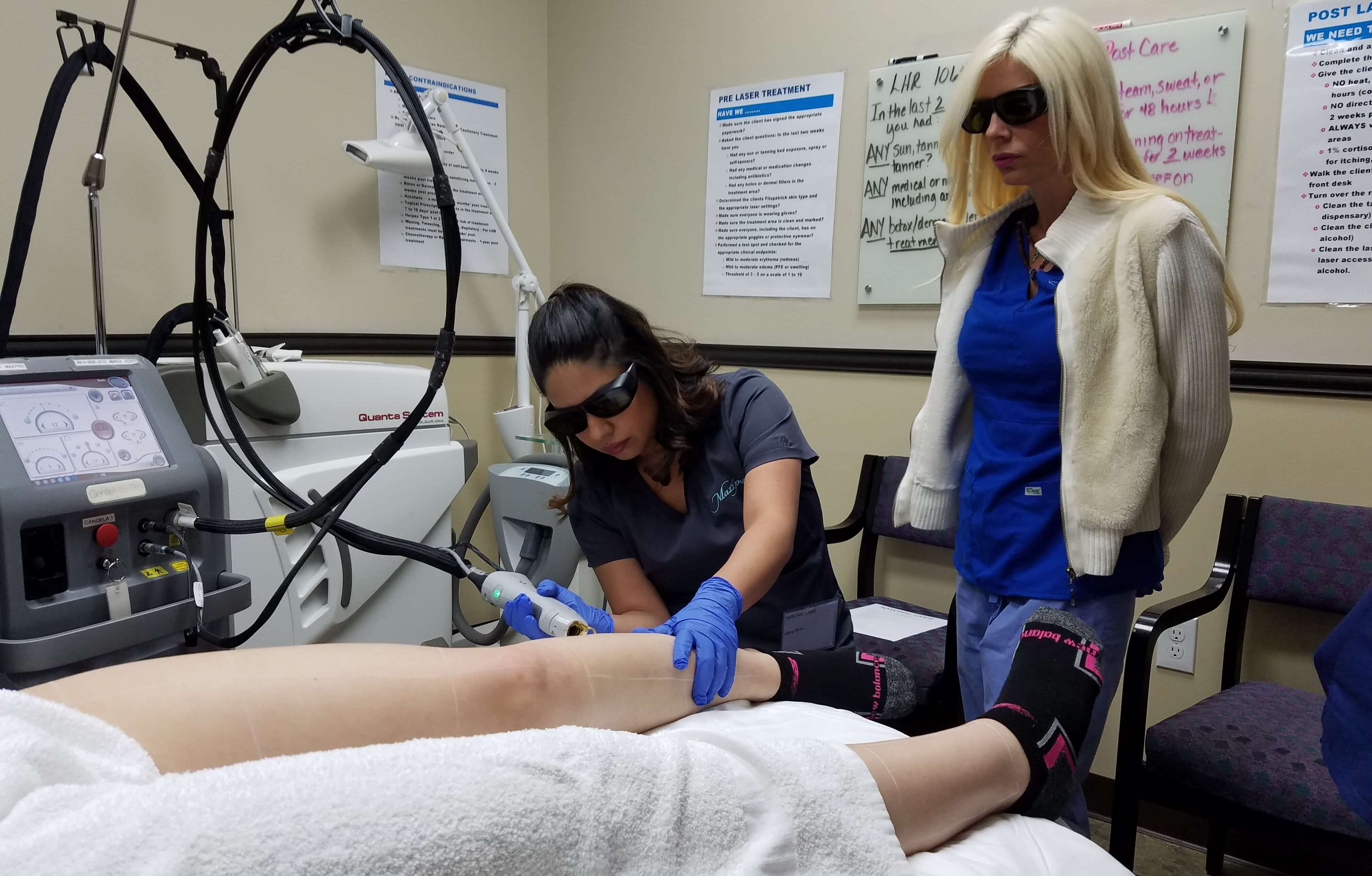Home>FAQs>How Long Do You Have To Wait Between Laser Hair Removal Sessions


FAQs
How Long Do You Have To Wait Between Laser Hair Removal Sessions
Modified: August 2, 2023
Find out how long you need to wait between laser hair removal sessions and get answers to your general questions about this popular hair removal method.
(Many of the links in this article redirect to a specific reviewed product. Your purchase of these products through affiliate links helps to generate commission for Under-tec.com, at no extra cost. Learn more)
Table of Contents
Introduction
Are you tired of constantly shaving, waxing, or plucking unwanted hair? If so, laser hair removal may be the solution you’ve been looking for. Laser hair removal is a popular and effective method of permanently reducing unwanted body hair, providing long-lasting smoothness and convenience. However, it is not an instant process. It requires multiple sessions to achieve optimal results. This brings up the question: how long do you have to wait between laser hair removal sessions?
The answer to this question is not as straightforward as you might think. The waiting time between laser hair removal sessions depends on several factors, such as the specific body area being treated, the individual’s hair growth cycle, and the type of laser technology being used. Understanding these factors will help you have realistic expectations and plan your laser hair removal journey effectively.
In this article, we will delve into the intricacies of the laser hair removal process and explore the recommended waiting time between sessions. We will also discuss the importance of following these guidelines to ensure the best possible results.
Understanding the Laser Hair Removal Process
Before we discuss the waiting time between laser hair removal sessions, let’s first understand how the process works. Laser hair removal targets the hair follicles beneath the skin’s surface, using concentrated beams of light to destroy them. The laser energy is absorbed by the dark pigment in the hair (melanin), which in turn damages the follicle and inhibits future hair growth.
It is important to note that laser hair removal is most effective on dark, coarse hair and is less effective on light or fine hair. Additionally, this treatment is more successful on individuals with lighter skin tones and may require special considerations for those with darker skin tones. Consulting with a board-certified dermatologist or professional laser technician will help determine if laser hair removal is a suitable option for you.
The laser hair removal process is gradual and requires multiple sessions to target different hair growth cycles. Hair grows in cycles, with individual hairs going through an active growth phase (anagen), a resting phase (telogen), and a shedding phase (catagen). The laser can only target actively growing hairs, which is why multiple sessions are necessary to target the different hairs in various stages of the growth cycle. The number of sessions required varies depending on factors such as hair type, body area, and individual response to treatment.
Each laser hair removal session typically lasts between 15 minutes to over an hour, depending on the size of the treatment area. The procedure can cause some discomfort, often described as a warm snapping sensation, but this can be minimized with the use of cooling devices and numbing creams.
Now that we have a basic understanding of how laser hair removal works, let’s explore the factors that influence the waiting time between sessions.
Factors That Influence the Waiting Time between Sessions
While the general timeline for laser hair removal sessions is typically spaced several weeks apart, the exact waiting time between sessions can vary depending on several factors. Understanding these factors will help you plan out your treatment schedule and ensure optimal results.
1. Hair growth cycle: As mentioned earlier, hair grows in cycles, and laser hair removal can only effectively target hairs in the active growth phase (anagen). Waiting for the hair to enter this phase is crucial for successful treatment. This means that the waiting time between sessions will depend on the specific body area being treated and the individual’s hair growth patterns.
2. Body area being treated: Different body areas have different hair growth rates and cycles. For example, the hair on the face tends to have a faster growth cycle compared to the hair on the legs or back. This means that the waiting time between sessions may be shorter for facial hair compared to body hair.
3. Type of laser technology: Different laser systems have different energy levels and target different hair types. The type of laser technology being used can also influence the waiting time between sessions. Some lasers may require longer intervals between sessions to allow the skin to recover and reduce the risk of side effects.
4. Individual response to treatment: Each individual’s body may respond differently to laser hair removal. Factors such as skin type, hair color, and thickness can affect how well the treatment works and how quickly results are achieved. The waiting time between sessions may need to be adjusted based on these individual factors.
It is important to consult with a qualified professional to determine the ideal waiting time for your specific situation. They will assess factors such as hair growth cycle, body area, and individual characteristics to create a customized treatment plan that maximizes results.
Now that we have explored the factors that influence the waiting time between laser hair removal sessions, let’s move on to the recommended time gaps between sessions.
Recommended Time Gaps between Laser Hair Removal Sessions
The recommended time gaps between laser hair removal sessions can vary depending on several factors. However, a general guideline is to schedule sessions between 4 to 6 weeks apart. This interval allows for the hair in different stages of the growth cycle to enter the active growth phase, ensuring that the laser effectively targets the maximum number of hair follicles.
During your initial consultation, a qualified professional will assess your specific needs and provide personalized recommendations for the waiting time between sessions. They will take into consideration factors such as your hair growth cycle, body area being treated, and the type of laser technology being used.
It is important to follow the recommended time gaps between sessions for several reasons. Firstly, adhering to the proper waiting time allows for the hair follicles to be effectively targeted during their active growth phase. Deviating from the recommended schedule may result in less efficient treatments and suboptimal results.
Additionally, spacing out the sessions allows your skin to heal and recover between treatments. Laser hair removal can cause temporary side effects such as redness, swelling, or skin sensitivity. Giving your skin enough time to recover reduces the risk of irritation or complications.
It is important to note that the recommended time gaps can vary for different body areas. For example, areas with faster hair growth, such as the face or underarms, may require shorter intervals between sessions, while areas with slower hair growth, such as the legs or back, may have longer intervals.
Always consult with your laser technician or dermatologist to determine the optimal waiting time for your specific treatment plan. They will closely monitor your progress and make any necessary adjustments to ensure the best possible outcomes. Following their guidance will help you achieve long-lasting results and minimize the chance of adverse reactions.
Now that we understand the recommended time gaps between sessions, let’s explore the waiting time for different body areas.
Waiting Time for Different Body Areas
The waiting time between laser hair removal sessions can vary depending on the body area being treated. The rate of hair growth and the response to treatment can differ across different parts of the body. Let’s explore the waiting time for common body areas:
- Face: The facial area, including the upper lip, chin, and cheeks, tends to have a faster hair growth cycle compared to other body areas. As a result, the waiting time between sessions for facial hair is typically shorter, ranging from 4 to 6 weeks.
- Underarms: The underarm area is another region with relatively fast hair growth. The recommended waiting time between laser hair removal sessions for the underarms is usually around 4 to 6 weeks.
- Bikini area: The bikini area refers to the hair that grows along the bikini line and in the pubic region. The waiting time between sessions for this area is generally consistent with other body areas, around 4 to 6 weeks.
- Legs: The hair on the legs tends to grow more slowly compared to areas like the face or underarms. Therefore, the waiting time between sessions for leg hair may be slightly longer, ranging from 6 to 8 weeks.
- Back and chest: The waiting time for larger areas, such as the back and chest, may also be slightly longer due to the larger treatment area. Depending on the hair growth patterns, the waiting time between sessions for these areas can range from 6 to 8 weeks.
It is essential to keep in mind that these waiting times are general recommendations and may vary based on individual factors. Your laser technician or dermatologist will assess your specific situation and provide personalized recommendations for the waiting time between sessions.
Following the recommended waiting time for each body area ensures that the laser effectively targets the hair follicles during their active growth phase and maximizes the chances of successful treatment. Deviating from the recommended schedule may result in less efficient treatments and suboptimal results.
Now that we have discussed the waiting time for different body areas, let’s understand the importance of following the recommended waiting time.
Importance of Following the Recommended Waiting Time
Following the recommended waiting time between laser hair removal sessions is crucial for achieving optimal results. While it may be tempting to schedule sessions closer together for quicker hair removal, deviating from the recommended schedule can have several negative consequences.
1. Targeting hair in the active growth phase: The laser beams used in hair removal treatments are most effective when they target hair follicles in the active growth phase. By following the recommended waiting time, you allow enough time for the hair to enter this phase. This ensures that the laser effectively targets the maximum number of hair follicles and provides the best possible results.
2. Minimizing the risk of complications: Laser hair removal treatments can cause temporary side effects such as redness, swelling, or skin sensitivity. These effects typically subside within a few hours or days. However, scheduling sessions too close together can increase the likelihood of these side effects persisting or becoming more severe. By following the recommended waiting time, you give your skin ample time to heal and recover, minimizing the risk of complications.
3. Allowing for gradual hair reduction: Laser hair removal is a gradual process that requires multiple sessions to achieve long-term hair reduction. The recommended waiting time between sessions ensures that each treatment builds upon the previous one, gradually reducing hair growth over time. By sticking to the proper schedule, you increase the likelihood of achieving your desired results in the most efficient and effective manner.
4. Avoiding unnecessary discomfort: Laser hair removal can cause some discomfort during treatment, such as a warm snapping sensation. Scheduling sessions too closely together can subject your skin to unnecessary and potentially uncomfortable sensations. By following the recommended waiting time, you give your skin adequate time to recover and minimize any discomfort associated with the procedure.
Remember, every individual’s body and hair type is unique, and the recommended waiting time may vary. It is essential to consult with a qualified professional who can assess your specific situation and provide personalized recommendations.
By following the recommended waiting time, you can ensure that your laser hair removal journey is effective, safe, and brings you closer to achieving the long-lasting smoothness you desire.
Now that we have explored the importance of following the recommended waiting time, let’s summarize the key points we have discussed in this article.
Conclusion
Laser hair removal is a popular method for achieving long-lasting hair reduction and smooth skin. However, it is important to understand that it is not an instant process. Multiple sessions are required to effectively target hair follicles in different stages of the growth cycle. The waiting time between laser hair removal sessions plays a crucial role in achieving optimal results.
Factors such as the body area being treated, hair growth cycle, type of laser technology, and individual response to treatment influence the recommended waiting time. Generally, sessions are spaced between 4 to 6 weeks apart, although this may vary depending on individual circumstances.
The waiting time for different body areas can also vary. Areas with faster hair growth, such as the face and underarms, may require shorter intervals between sessions, while areas with slower hair growth, such as the legs or back, may have longer intervals.
Following the recommended waiting time is essential for maximizing the effectiveness of laser hair removal treatments. It allows for the targeting of hair in the active growth phase, minimizes the risk of complications, and promotes gradual hair reduction. Deviating from the recommended schedule may lead to less efficient treatments and suboptimal results.
Consulting with a qualified professional is crucial in determining the ideal waiting time for your specific situation. They can assess your hair growth cycle, body area being treated, and individual characteristics to create a customized treatment plan that meets your needs.
By adhering to the recommended waiting time and following your treatment plan, you can achieve long-lasting hair reduction and enjoy the convenience of smooth, hair-free skin. So, say goodbye to the endless cycle of shaving and waxing and embrace the benefits of laser hair removal.
Remember, the journey to permanent hair reduction requires patience and commitment, but the results are well worth it. Consult with a trusted professional, follow their guidance, and enjoy the freedom of smooth skin with laser hair removal.








